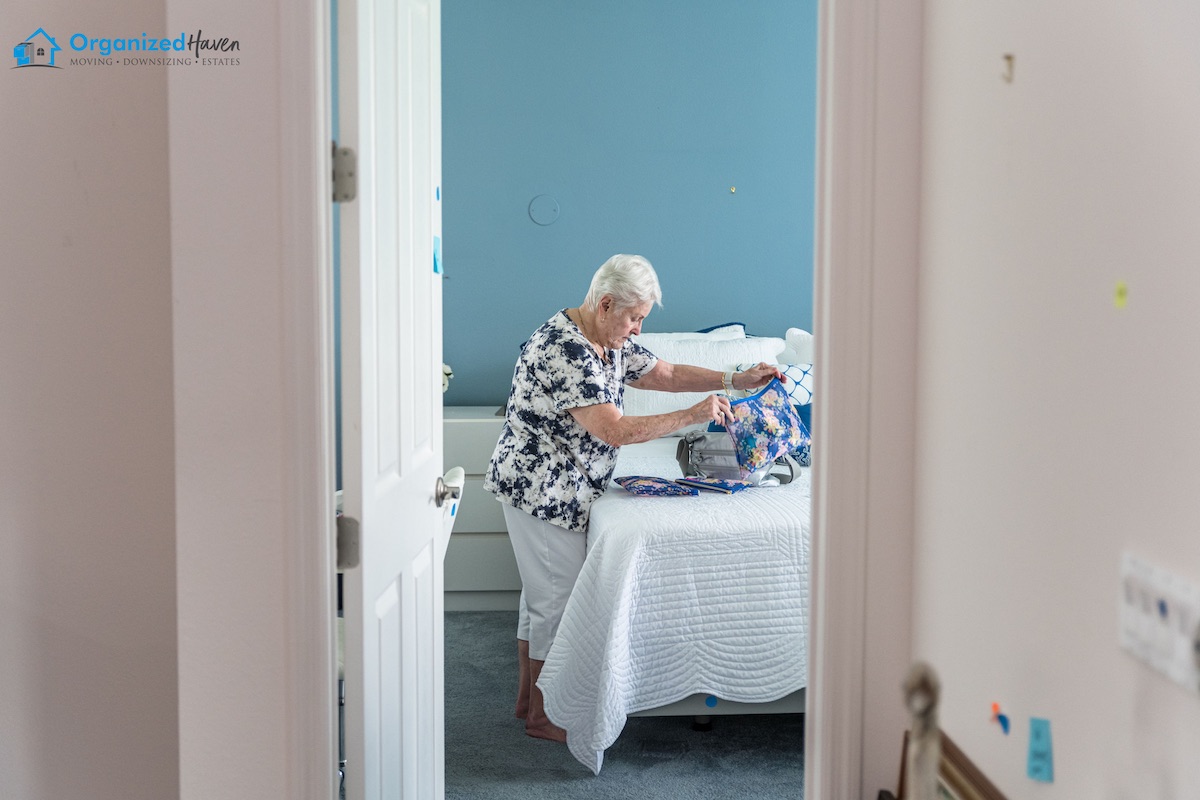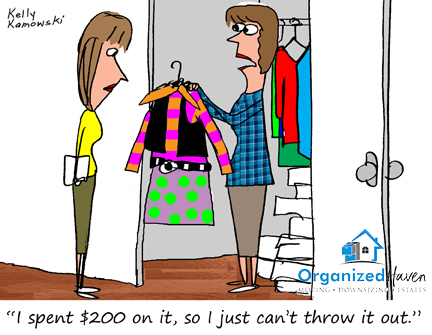At the beginning of working with someone who wants to get organized, their perceived problem is that they don’t know how to organize, and they don’t have the proper organizing tools and supplies. However, what they don’t realize is that organizing IS the problem!
As a professional organizer and downsizing specialist, I know that learning how to fold or store something is not going to help me or anyone else get organized and stay organized. While organizing products help to add functionality and purpose to a space, they are not going to be THE things that change a person’s life.
The true problem is having too much stuff. More specifically, WHY we have too much stuff. The professional organizing industry sees eight common barriers to letting go of stuff.
It is not a simple process. You can’t just get rid of everything you don’t use, because that’s not really what matters.
What does matter, is having a less chaotic, cluttered, and stressful home. Sure, letting go of some of your possessions will help you get there, but you will quickly keep running into barriers that will stop you.
These barriers will stop you from living the life that you want, and you may feel as if you will never break free from your stuff.
WHY IS LETTING GO OF STUFF SO HARD AND HOW CAN I OVERCOME IT?
It isn’t about the stuff. It really is about the psychological and emotional barriers that stand in our way of letting go. These barriers appear as voices in our heads telling us to “keep” the item.
SUNK COST – “I paid good money for this.”
The sunk-cost attachment keeps you attached to something because of how expensive it was, rather than what you might get out of it in the future. You are focused on the cost vs. the value. You forget that you did get value out of using and loving it OR it was a poor purchasing decision, and it brings you negative feelings.
Either way, the way to overcome this attachment is to value your current quality of life more than valuing the decisions of the past.
RECOUP THE COST – “I could sell this.” or “This is worth something.”
With this barrier, you are willing and able to let go, but now you’re attaching value to the item by the compensation you might get in exchange for it. The bargaining thoughts enter your head, and your inner negotiator takes over.
The problem with this begins when you don’t create a real plan to sell it and just continue to hold onto it without an exit strategy. Usually, the value of the space, time and energy you’re allotting to the item exceeds the value you could receive by selling it and moving on.
Overcome this by taking time to research and understand the “value” of the item (i.e. what has the item SOLD for online?) and then make a SMART plan to let it go.
GUILT – “I’d feel too guilty to let go of this.”
This is one of the strongest barriers to letting go. We feel guilt when we let go of a gift given to us by someone that we care about. We fear that the person will feel betrayed if we let go of their gift.
This protection of others’ feelings prevents us from meeting the goals of how we want to live. These fears are unrealistic, and we need to stand up to them!
Read more tips for downsizing your possessions without feeling guilt here: https://www.redfin.com/blog/tips-for-downsizing-your-possessions/. I had the honor of being one of the downsizing expert contributors for this article!
PURPOSELESS PRACTICALITY – “This is still good.”
This statement stops us from further analyzing the item and whether it is something we need or want.
An item being “perfectly good” is practical but serves no purpose for your current and foreseeable life. You can let it go to someone whose life it can serve.
FUTURE FEAR – “I might need this someday.”
This too is about being smart and “practical.” Holding onto things for a future fear that you might need them someday focuses on worrying instead of making a choice based on logic and reason.
Value your space and the life that you live today — don’t worry about a future you can’t control. However, do identify the reasons for your fears — then you can learn to understand how to let them go.
SENTIMENTALITY – “It reminds me of a time,” or “It reminds me of someone,” or “I wouldn’t want to forget.”
We all have the items in our homes that are sentimental — keepsakes, mementos, memorabilia. They come in many forms, such as:
-
- Photos and artwork
- Baby outfits and blankets
- Graduation tassels
- Programs and trophies
- Greeting cards and letters
- Report cards and school papers
- Love letters
- Newspaper clippings
They are tokens of our identities, the people in our lives, and of those who’ve passed away. The mere existence of these items isn’t the problem, rather, the problem is when we are holding onto too much of it.
If we make a goal of reducing what we have, we can then have the pleasure of saying, “I enjoy the memory that this item brings me, however, I can live without it. I can let go of this.”
PERCEIVED VALUE TO SOMEONE ELSE – “I could give this as a gift” or “I want this to go to someone who will appreciate it” or “My kids will want this.”
This is a challenge that I often see with my senior clients. They aren’t quite willing to accept when their kids say they don’t want an item, especially if it is an heirloom, antique, or has been passed down from generations.
Your own personal attachment to an item and your assumption that others will appreciate and value it the same way that you do, creates a desire to hold onto it. It becomes a problem when you find that there isn’t a market for the item, and you remain in disbelief.
To overcome this barrier, we must understand that we are not being rejected when someone doesn’t value something the same way we do. We must accept how society has changed and continues to change, and that people value different things than in days past. We must find methods of action that satisfy our goal of letting go of the item and finding real value in our space and current life.
WANT TO DISPOSE OF IT SAFELY OR SMARTLY – “I don’t know how to get rid of this safely, so I’ll just hold onto it.”
Last, but not least, and like all the rest, this one comes from a well-meaning place. Our responsibility towards the environment and our goal for responsible disposal has a foundation in values, ethics, and duty.
When that responsibility becomes a sole reason to hold onto an item that would otherwise leave the home and prevents the person from living a clutter-free life, it becomes a barrier.
This is another “someday” example. There is a conflict between your goal of living with less stuff, less clutter, and less stress, and your resistance to letting go of things in a way that feels irresponsible.
The desire to keep things out of a landfill should not put you in a position of just surrendering to keep it indefinitely. If it does, it will start as just one item here and another one there. These piles will accumulate in your home, and you might think you’re saving the planet, but you will be doing so at the expense of your home.
Confront your barriers, make peace with your actions, and meet your goals for how you want to live in your home!
What barriers are holding you back from achieving your organizing goals?
If you want to learn more on how to “Break Free from Your Stuff, Even When Your Head and Heart Get in the Way,” read Clever Girl’s Guide to LIVING WITH LESS, by Kathy Vines, CPO®.
PIN IT to remember it!
Happy letting go!
💙,
Nicole
By: Nicole Ramer, SMM~C
(Professional Organizer & Certified Senior Move Manager®)




0 Comments